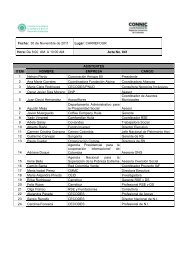Setting new standards - Friends Life
Setting new standards - Friends Life
Setting new standards - Friends Life
You also want an ePaper? Increase the reach of your titles
YUMPU automatically turns print PDFs into web optimized ePapers that Google loves.
PARENT COMPANY ACCOUNTS<br />
ABBREVIATIONS AND DEFINITIONS<br />
Notes to the consolidated accounts continued<br />
30. Risk management objectives and policies for<br />
mitigating risks continued<br />
Deferred annuities are contracts whereby there is a promise to pay a<br />
life annuity starting from a specified date in the future. These<br />
policies are subject to a similar risk from the impact of longevity, the<br />
only difference being that the risk of adverse impact is greater given<br />
that the annuity is payable further into the future. However, most of<br />
these policies are with-profits and the impact would be offset by a<br />
reduction in the FFA, with relatively little resulting impact on<br />
shareholder profits.<br />
A 5% reduction in annuitant mortality would reduce post-tax IFRS<br />
profit and equity by £31m (2005: £32m). This takes into account the<br />
impact from increasing the provision for future mortality as well as<br />
the impact from paying more annuity than expected. A 5% increase<br />
in expected annuitant mortality would increase post-tax profit and<br />
equity by £28m (2005: £29m). These impacts assume that the<br />
reserving basis changes to reflect experience.<br />
The impact of a mortality shock on term assurance business would<br />
normally be at least partially offset by a favourable impact on the<br />
annuity book.<br />
(ii) Policyholder decision risk<br />
Persistency experience varies over time as well as from one type of<br />
contract to another. Factors that will cause lapse rates to vary over<br />
time include changes in investment performance of the assets<br />
underlying the contract where appropriate, regulatory changes that<br />
make alternative products more attractive, customer perceptions of<br />
the insurance industry in general and the Group in particular, and the<br />
general economic environment.<br />
The immediate impact on IFRS profit of a change in lapse rates is<br />
relatively small. An increase in lapse rates will normally result in a<br />
small reduction in profit due mainly to eliminating the deferred<br />
acquisition cost asset in respect of the insurance contracts that<br />
lapse. However the impact is much smaller than the effect of other<br />
factors considered here. Lapses have a more significant effect on<br />
the Group’s other basis of measurement – being EEV profit.<br />
The valuation of the Group’s guarantees and options is described in<br />
note 27. As stated in that note, the cost of guaranteed annuity<br />
options is dependent on decisions made by policyholders such as<br />
policy discontinuance and tax-free cash take-up. These assumptions<br />
are set by reference to recent experience.<br />
(iii) Expense risk<br />
Though under IFRS 4 expense risk is not a component of insurance<br />
risk, it is an important financial risk in the context of insurance and<br />
investment contracts.<br />
The whole of the impact of changes in expense levels is borne by<br />
shareholders with the following exceptions. In 2009 the charges<br />
made to the FPLP With-Profits Fund for managing policies will be<br />
reviewed to reflect market rates at the time. Pre-demutualisation<br />
with-profits policyholders will bear the impact of any resulting<br />
changes to charges. Also FPLA closed fund with-profits<br />
policyholders bear the full expense risk for the fund.<br />
Contractual terms for unit-linked and unitised with-profits products<br />
include provision for increases in charges. Certain expenses (such<br />
as fees/commissions) are fixed at the time a contract is written.<br />
If the remaining re<strong>new</strong>al expenses were to increase by 10%, the<br />
impact on post-tax profits and equity would be approximately £15m<br />
(2005: £14m).<br />
(c) Credit risk<br />
Credit risk can be described as the risk of loss due to the default of<br />
a company, individual or country, or a change in investors’ risk<br />
appetite. It includes investment credit risk, derivative and<br />
reinsurance counterparty risks, deposit and loan risks.<br />
The <strong>Life</strong> & Pensions business will take on investment credit risk and<br />
loan risk when it is deemed financially beneficial to do so in support<br />
of the Group’s strategic objectives (eg on making an investment<br />
decision between two corporate bonds of differing credit quality, the<br />
default risk of the lower rated bond would be weighed up against<br />
the additional yield gained with a view to ensuring that the expected<br />
reward exceeded the potential cost of the default risk). F&C actively<br />
pursues credit risk in relation to the impact on management fees of<br />
credit events. The Group is averse to most other types of credit risk,<br />
in particular that related to the default of derivative counterparties,<br />
reinsurers and deposit takers.<br />
To mitigate credit risk:<br />
• Investment mandates for many funds will have a prescribed<br />
minimum credit rating of bonds that may be held. Investing in a<br />
diverse portfolio reduces the impact from individual companies<br />
defaulting.<br />
• Counterparty limits are set for investments, cash deposits, foreign<br />
exchange trade exposure and stock lending.<br />
• All derivative transactions are covered by collateral and derivatives<br />
are only taken out with counterparties with a suitable credit rating.<br />
• The Group regularly reviews the financial security of its reinsurers.<br />
In F&C, credit risk (including derivative counterparty risk) is managed<br />
by the application of a strict investment policy designed to limit<br />
exposure to companies with poor credit ratings and to avoid undue<br />
investment with any single counterparty. Regular meetings are held<br />
to consider credit developments and all credit exposures are<br />
reviewed at least annually. Collateral is not usually obtained for credit<br />
risk exposures on derivative instruments, except where margin<br />
deposits are required from counterparties.<br />
The Group is subject to the risk of increases in credit spreads<br />
reducing the value of corporate bonds. Bases for valuing liabilities<br />
will reflect bond yields, reduced for default risk. To the extent that<br />
the increase in credit spreads reflects an increase in actual default<br />
rates, this will result in a reduction in profits. A 0.25% pa increase in<br />
average credit spread which is reflected by an increase in actual<br />
defaults will reduce post-tax profit and equity by £60m (2005: £70m).<br />
<strong>Friends</strong> Provident Annual Report & Accounts 2006 149

















